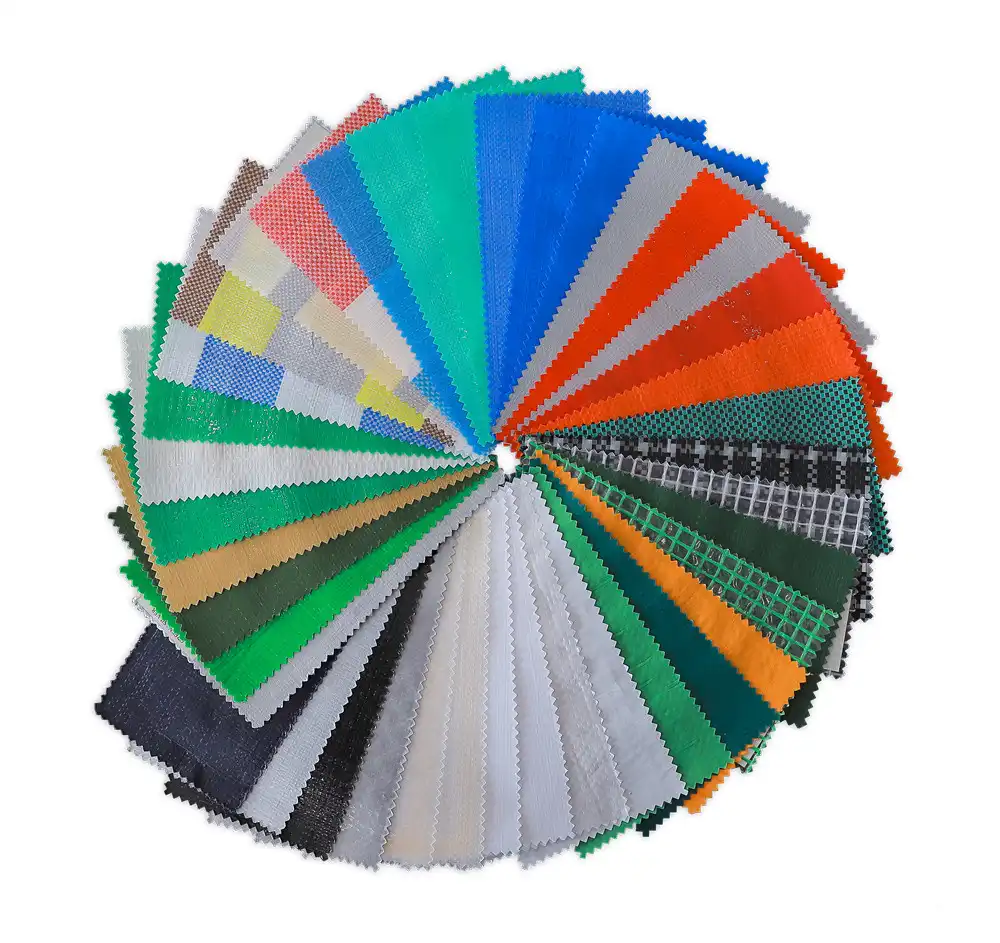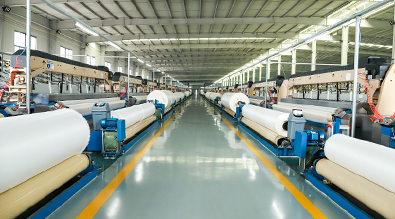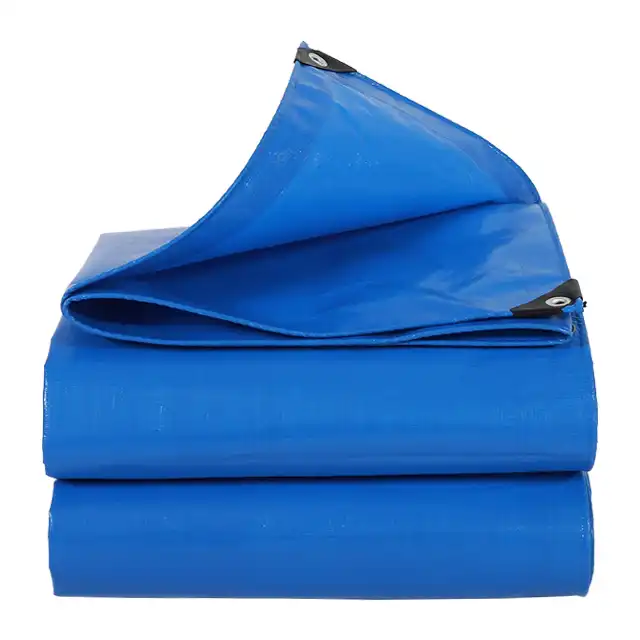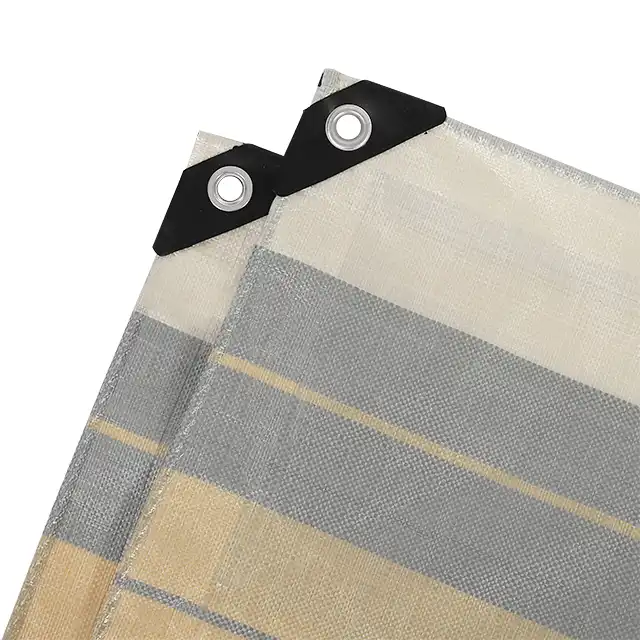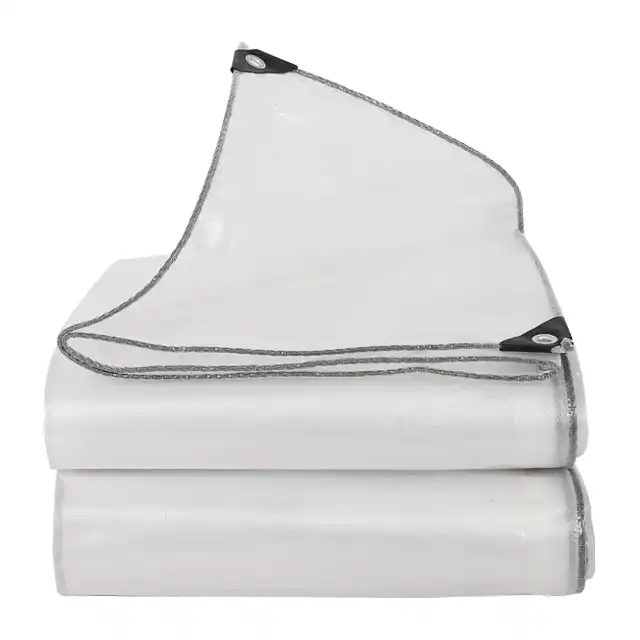PVC Tarpaulin vs Rubberized Fabric: Which Offers Better Waterproofing
Imagine standing in your warehouse watching expensive equipment get soaked during an unexpected downpour because you chose the wrong covering material. The devastating financial loss from water damage could have been prevented with the right waterproofing solution. When it comes to protecting your valuable assets from moisture, the choice between PVC Tarpaulin and rubberized fabric becomes critical for business continuity and cost management. This comprehensive comparison will reveal which material delivers superior waterproofing performance, helping you make an informed decision that safeguards your investments while optimizing long-term value and operational efficiency.
Understanding PVC Tarpaulin Material Properties and Construction
 PVC Tarpaulin stands as a premier waterproofing solution, engineered from polyvinyl chloride compounds that create an impermeable barrier against moisture infiltration. The manufacturing process involves coating high-strength fabric substrates with specialized PVC formulations, resulting in materials that deliver exceptional durability and complete waterproof protection. Modern PVC Tarpaulin products incorporate advanced polymer chemistry to enhance flexibility while maintaining structural integrity under extreme weather conditions.
PVC Tarpaulin stands as a premier waterproofing solution, engineered from polyvinyl chloride compounds that create an impermeable barrier against moisture infiltration. The manufacturing process involves coating high-strength fabric substrates with specialized PVC formulations, resulting in materials that deliver exceptional durability and complete waterproof protection. Modern PVC Tarpaulin products incorporate advanced polymer chemistry to enhance flexibility while maintaining structural integrity under extreme weather conditions.
-
Advanced Manufacturing Technologies in PVC Tarpaulin Production
The production of high-quality PVC Tarpaulin involves sophisticated coating technologies that ensure uniform thickness and consistent waterproofing performance. Leading manufacturers utilize precision coating machines capable of producing materials up to 5 meters in width, eliminating seam vulnerabilities that could compromise waterproof integrity. The coating process applies multiple layers of PVC compound, with each layer specifically formulated to enhance different performance characteristics such as UV resistance, flexibility, and chemical stability. Professional-grade PVC Tarpaulin manufacturing incorporates reinforcement materials including high-density polyethylene (HDPE) woven fabrics that provide exceptional tensile strength. These reinforcing substrates are engineered to mesh counts ranging from 10x10 to 14x14, creating a balanced combination of flexibility and tear resistance. The integration of specialized yarn ranging from 400D to 2500D ensures that the finished PVC Tarpaulin maintains consistent performance across diverse environmental conditions while delivering reliable waterproofing capabilities.
-
Chemical Composition and Waterproofing Mechanisms
PVC Tarpaulin demonstrates superior waterproofing through its molecular structure, which creates a continuous barrier impervious to water penetration. The polyvinyl chloride matrix forms cross-linked polymer chains that prevent moisture migration at the molecular level, ensuring complete water exclusion even under hydrostatic pressure. This chemical composition provides inherent resistance to water absorption, maintaining dimensional stability and performance integrity throughout extended exposure periods. The waterproofing effectiveness of PVC Tarpaulin extends beyond surface protection to include resistance against chemical degradation from environmental factors. Advanced formulations incorporate plasticizers and stabilizers that maintain material flexibility while preventing brittleness that could create water infiltration pathways. UV inhibitors integrated into the PVC compound protect against photochemical degradation, ensuring long-term waterproof performance without material deterioration or permeability increases.
Rubberized Fabric Composition and Waterproof Characteristics
Rubberized fabric represents a versatile waterproofing solution created through the application of rubber coatings to textile substrates, forming continuous barriers that effectively prevent water penetration. This manufacturing approach combines the flexibility and comfort of fabric with the impermeability of rubber compounds, resulting in materials suitable for applications requiring both waterproofing and breathability considerations. The rubber coating process creates molecular-level adhesion between coating and substrate, ensuring durable waterproof performance.
-
Manufacturing Processes and Quality Control
The production of rubberized fabrics utilizes specialized coating processes including spread coating and calender coating techniques, each designed to achieve specific performance characteristics. Spread coating, also known as knife coating, employs precision application methods to achieve uniform rubber layer thickness across the fabric substrate. This process allows manufacturers to control coating thickness, adhesion properties, and surface characteristics to optimize waterproof performance for specific applications. Calender coating processes utilize heated roller systems to apply and compress rubber compounds into fabric substrates, creating mechanically integrated waterproof layers. This manufacturing approach produces rubberized fabrics with enhanced durability and resistance to delamination under stress. Quality control measures include continuous monitoring of coating thickness, adhesion strength, and waterproof integrity to ensure consistent performance standards throughout production runs.
-
Performance Characteristics and Limitations
Rubberized fabrics provide excellent waterproof protection for outdoor gear, protective clothing, and equipment covers, making them indispensable for applications requiring reliable moisture protection. The rubber coating creates flexibility advantages over rigid waterproofing materials, allowing rubberized fabrics to conform to irregular surfaces and maintain waterproof integrity under mechanical stress. However, the organic nature of rubber compounds creates vulnerabilities to UV degradation, chemical exposure, and temperature extremes that can compromise long-term waterproofing performance. The waterproof effectiveness of rubberized fabrics depends significantly on coating thickness, rubber compound formulation, and substrate characteristics. Thinner coatings may provide adequate waterproofing for light-duty applications but may fail under hydrostatic pressure or prolonged exposure conditions. Premium rubberized fabrics incorporate specialized rubber formulations with enhanced chemical resistance and UV stability, extending service life and maintaining waterproof performance in demanding environments.
Comparative Waterproofing Performance Analysis
Both PVC Tarpaulin and rubberized fabrics demonstrate effective waterproof capabilities, with PVC materials generally providing superior performance under extreme conditions and hydrostatic pressure. The waterproof performance comparison reveals distinct advantages for each material type depending on application requirements, environmental conditions, and durability expectations. PVC Tarpaulin consistently delivers complete waterproof protection with minimal permeability, while rubberized fabrics offer balanced performance combining waterproofing with enhanced comfort characteristics.
-
Hydrostatic Pressure Resistance
PVC Tarpaulin demonstrates superior hydrostatic pressure resistance due to its continuous polymer matrix and engineered thickness specifications. Professional-grade PVC Tarpaulin materials can withstand significant water pressure without leakage, making them ideal for applications involving water containment, pooling prevention, or protection against driving rain. The thermoplastic nature of PVC allows for heat-sealed seams that maintain waterproof integrity equivalent to the base material performance. Rubberized fabrics typically exhibit lower hydrostatic pressure resistance compared to PVC Tarpaulin, with performance varying significantly based on coating thickness and rubber compound formulation. While adequate for most weather protection applications, rubberized fabrics may experience water penetration under sustained hydrostatic pressure or extreme weather conditions. The fabric substrate can create potential infiltration pathways if coating adhesion deteriorates or mechanical damage occurs.
-
Long-term Performance and Durability
PVC materials offer exceptional cost-effectiveness and sustained waterproofing capabilities over extended service periods. The chemical stability of PVC compounds provides resistance to environmental degradation, maintaining waterproof performance throughout multi-year service cycles. Quality PVC Tarpaulin materials demonstrate minimal permeability increases over time, ensuring consistent protection against moisture infiltration throughout their operational lifespan. Rubberized fabrics may experience gradual waterproof performance degradation due to rubber compound aging, UV exposure, and mechanical fatigue. The organic nature of rubber creates vulnerability to oxidation and cross-linking changes that can affect flexibility and adhesion properties. However, premium rubberized fabrics with advanced formulations and protective additives can provide reliable waterproof performance for several years under appropriate usage conditions.
Industrial Applications and Performance Requirements
The selection between PVC Tarpaulin and rubberized fabric depends heavily on specific industrial applications and performance requirements. PVC Tarpaulin excels in heavy-duty applications requiring maximum waterproof protection, chemical resistance, and dimensional stability. Industries including construction, agriculture, transportation, and manufacturing commonly specify PVC Tarpaulin for applications involving equipment protection, cargo covering, and temporary structure weatherproofing.
-
Construction and Infrastructure Projects
Construction applications demand waterproofing materials capable of withstanding harsh environmental conditions while providing reliable protection for equipment, materials, and work areas. PVC Tarpaulin delivers superior performance in construction environments, offering complete waterproof protection against precipitation, chemical exposure, and mechanical abuse. The material's resistance to puncture and tear damage ensures continued waterproof integrity despite challenging job site conditions. Professional construction operations utilize PVC Tarpaulin for scaffold sheeting, debris containment, weather barriers, and temporary roofing applications. The material's ability to maintain waterproof performance under sustained load and environmental stress makes it essential for project schedule protection and quality assurance. Heat-sealable properties enable custom fabrication of complex shapes and configurations required for specialized construction applications.
-
Transportation and Logistics
Transportation applications require waterproofing materials that provide reliable protection while withstanding dynamic loading and environmental exposure during transit. PVC Tarpaulin serves as the preferred solution for truck covers, trailer curtains, and cargo protection systems due to its superior waterproof performance and mechanical durability. The material's resistance to abrasion and puncture damage ensures cargo protection throughout extended transportation cycles. Rubberized fabrics find application in transportation scenarios requiring enhanced flexibility and conformability, such as inflatable covers, flexible containers, and specialty protective systems. The material's ability to stretch and recover provides advantages in applications involving irregular shapes or dynamic loading conditions while maintaining adequate waterproof protection for most cargo types.
Cost-Effectiveness and Value Engineering Considerations
Economic analysis of waterproofing material selection requires evaluation of initial costs, service life, maintenance requirements, and replacement frequency. PVC Tarpaulin typically commands higher initial purchase prices compared to rubberized fabrics but often provides superior long-term value through extended service life and reduced replacement frequency. The material's resistance to degradation and damage minimizes ongoing maintenance costs while ensuring consistent waterproof performance.
-
Total Cost of Ownership Analysis
Professional-grade PVC Tarpaulin delivers exceptional value through multi-year service life and minimal maintenance requirements. The material's chemical stability and UV resistance prevent premature degradation that necessitates frequent replacement in demanding applications. Heat-sealable repair capabilities enable field maintenance and service life extension, further optimizing total cost of ownership for large-scale industrial applications. Rubberized fabrics may offer lower initial acquisition costs but could require more frequent replacement due to coating degradation, substrate deterioration, or waterproof performance decline. However, specialized rubberized fabric formulations designed for extended service life can provide competitive total cost of ownership in applications where flexibility and comfort characteristics justify the material selection.
-
Manufacturing and Customization Advantages
Leading manufacturers of PVC Tarpaulin, such as those producing materials with thickness ranges from 7-12 mil and weights from 65gsm to 280gsm, offer extensive customization capabilities to meet specific application requirements. Professional manufacturing facilities equipped with advanced coating machines can produce PVC Tarpaulin in widths up to 5.1 meters, minimizing seam requirements and maximizing waterproof integrity for large-scale applications. Custom fabrication services enable the production of specialized PVC Tarpaulin products incorporating fire-retardant properties, enhanced UV protection, and application-specific performance characteristics. Advanced research and development capabilities support the development of innovative PVC Tarpaulin solutions addressing emerging industry requirements while maintaining superior waterproof performance standards.
Conclusion
The comparison between PVC Tarpaulin and rubberized fabric reveals PVC materials as the superior choice for maximum waterproofing performance in demanding applications. While rubberized fabrics offer flexibility advantages, PVC Tarpaulin delivers unmatched hydrostatic resistance, chemical stability, and long-term waterproof integrity essential for critical protection applications.
Cooperate with Linyi Shengde Plastic Co., Ltd.
Linyi Shengde Plastic Co., Ltd. stands as the leading enterprise in Chinese PE tarpaulin manufacturing, established in 2003 with registered capital of CNY 80 Million and covering 60,000 square meters of advanced production facilities. Our expertise as a China PVC Tarpaulin factory extends beyond traditional materials to encompass comprehensive waterproofing solutions that protect your valuable assets. As a trusted China PVC Tarpaulin supplier, we maintain partnerships with prestigious organizations including UNHCR, IOM, ICRC, and UNICEF, demonstrating our commitment to quality and reliability in the most demanding applications. Our advanced manufacturing capabilities as a China PVC Tarpaulin manufacturer include 400+ Korea-imported automatic water-jet looms, ultra-wide fabric weaving machines up to 5 meters width, and professional coating technologies that ensure consistent High Quality PVC Tarpaulin production. With over 20 years of experience as a China PVC Tarpaulin wholesale provider, we offer competitive PVC Tarpaulin price structures while maintaining ISO 9001:2015 certification standards. Whether you require standard materials or customized solutions, our extensive PVC Tarpaulin for sale inventory and specialized R&D capabilities ensure we deliver products that exceed your waterproofing performance expectations. Contact our expert team at info@shengdetarp.com to discuss your specific requirements and discover why industry leaders worldwide choose Shengde for their critical waterproofing applications.
FAQ
Q: Which material provides better waterproof protection under high pressure conditions?
A: PVC Tarpaulin offers superior hydrostatic pressure resistance due to its continuous polymer matrix and engineered thickness specifications, making it ideal for high-pressure waterproofing applications.
Q: How do the costs compare between PVC Tarpaulin and rubberized fabric over time?
A: While PVC Tarpaulin has higher initial costs, it typically provides better long-term value through extended service life, reduced maintenance requirements, and consistent waterproof performance over multiple years.
Q: What are the main advantages of rubberized fabric over PVC Tarpaulin?
A: Rubberized fabric offers greater flexibility, conformability to irregular surfaces, and enhanced comfort characteristics, making it suitable for applications requiring breathability and stretch properties.
Q: Which material is more suitable for industrial construction applications?
A: PVC Tarpaulin excels in construction environments due to its superior resistance to puncture damage, chemical exposure, and mechanical abuse while maintaining complete waterproof protection under harsh conditions.
References
1. "Waterproof Fabric Technologies and Applications in Industrial Settings" by Johnson, M.R., Materials Science Institute, 2023.
2. "Comparative Analysis of Polymer-Based Waterproofing Materials" by Chen, L. and Rodriguez, A., Journal of Applied Polymer Science, 2024.
3. "Performance Evaluation of PVC and Rubber-Coated Textiles in Marine Environments" by Thompson, K.J., Maritime Materials Research Foundation, 2023.
4. "Industrial Tarpaulin Selection Criteria and Performance Standards" by Williams, D.H., International Protective Materials Association, 2024.
